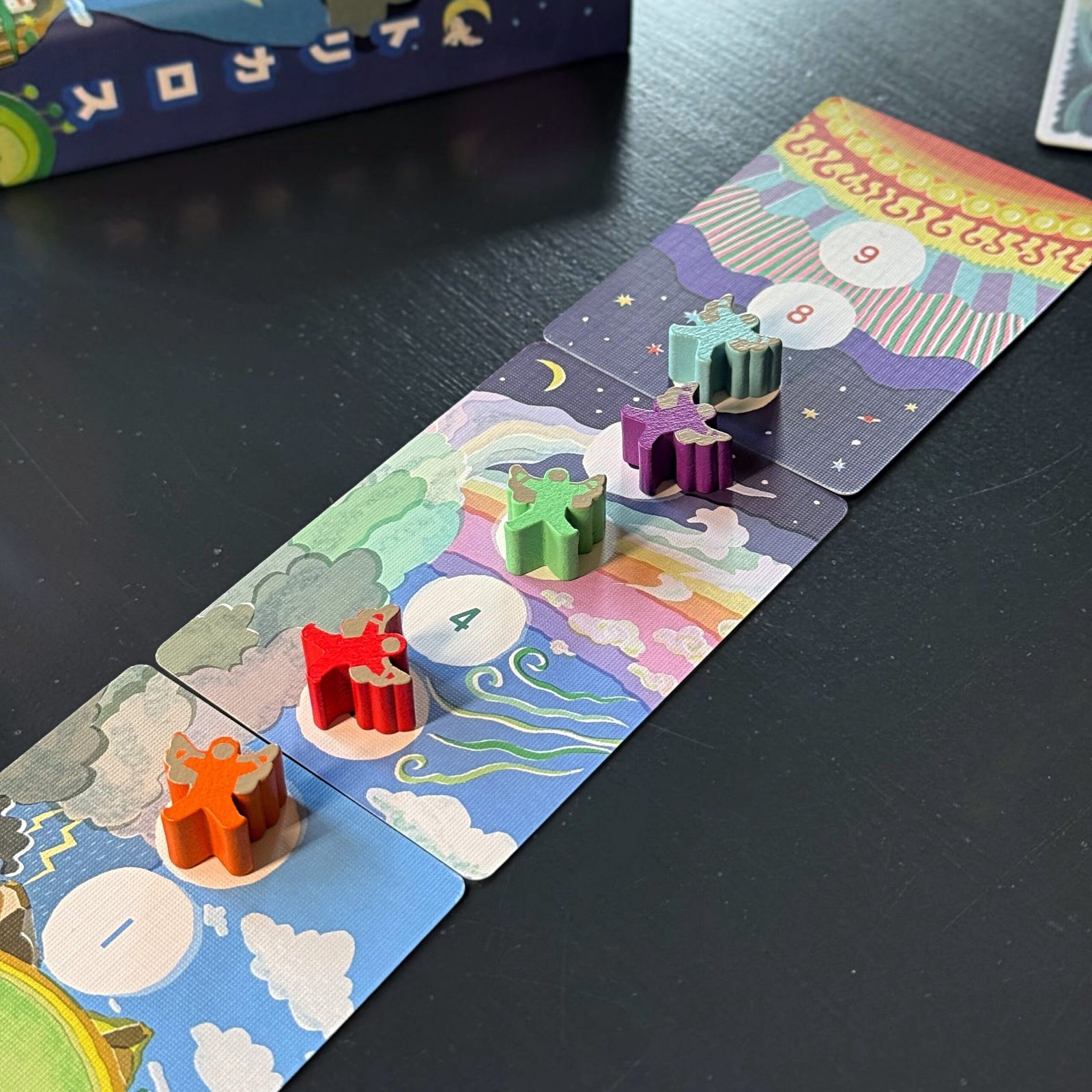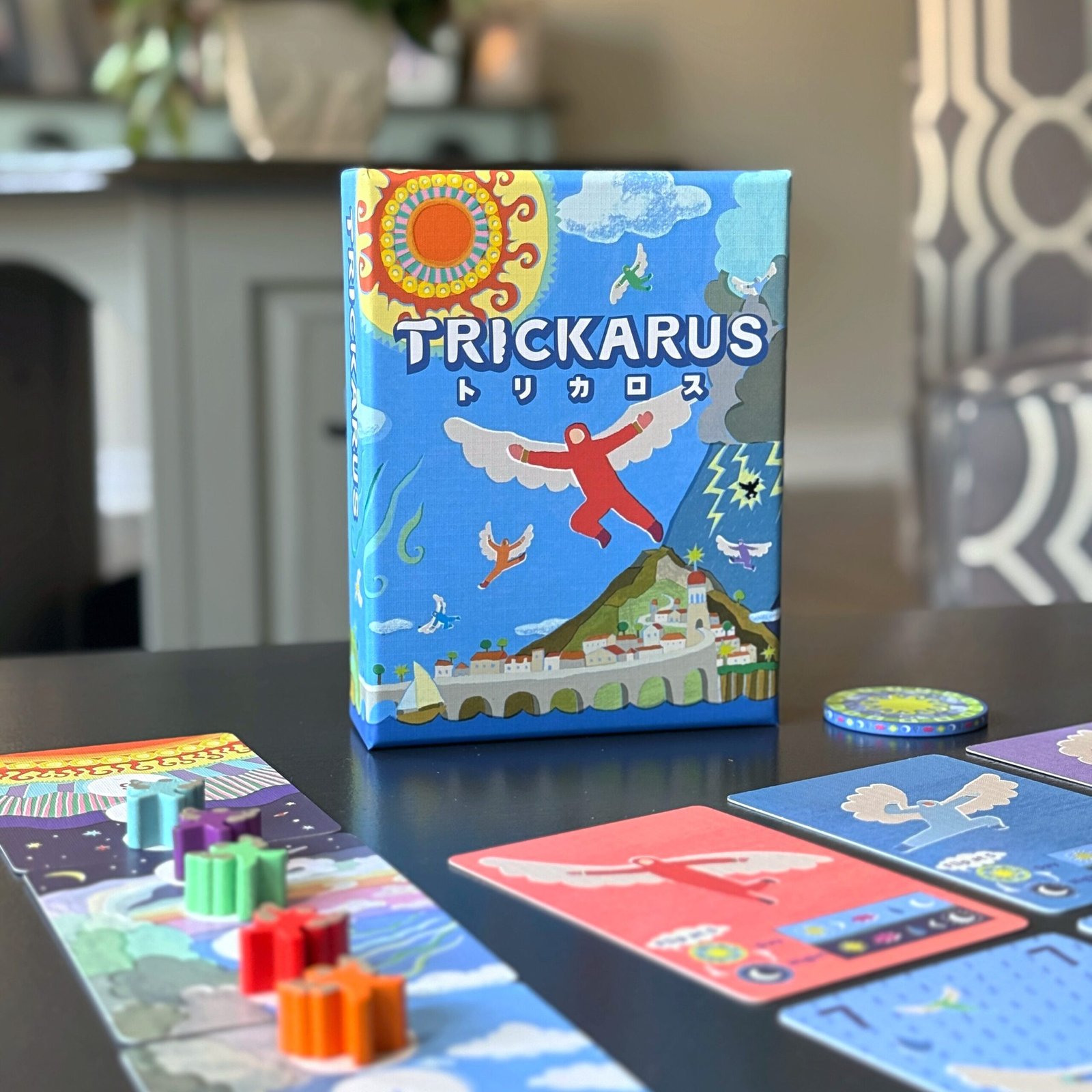I Am The Danger.
One of the most satisfying things about games, whether light or heavy, strategic or silly, is feeling like you can bend them to your will. Not through brute force, but through timing, subtle manipulation, and knowing exactly when to strike.
Games that hand you the tools to shift momentum, steer outcomes, or tilt the scales without breaking the rules tend to stick with us.
They invite obsession. Rewarding those who understand the machinery humming beneath the surface and know exactly when to pull the lever, flip the switch, or… flip the game upside down. But plan poorly, and you’ll be left battered and bruised, entirely by your own hand.

Trickarus: A Hidden Gem That Turns Itself Upside Down
Lately, a hidden gem we’ve been obsessed with is Trickarus, a lesser-known Japanese trick-taking game that marries familiar card play with a thematic spin on the Icarus myth. At first glance, with its childish art, the game may seem like light nonsense: follow suit, highest card wins.
Classic.
Predictable.
Beige.
And then, it turns the game on its head. Literally.
How It Plays
The cards in Trickarus are double-ended; one half representing day, the other night. During the day, the suits on the Sun half trump. But when night falls, everything flips, and now the Moon suits trump. If a 5 is played of any suit, rotate your entire hand 180°, changing both the cards’ time of day and values. Every number except 0 adds to 10 across its two sides. Those pitiful 1s you were holding? Now 9s, burning bright.
But where the game gets deliciously unstable and brings out the true manipulation is that the flip can happen mid-trick. Cards already played don’t escape the chaos—they’re instantly inverted as well. Suddenly, the trick you were winning doesn’t look so good.

5s are powerful, chaotic weapons, and tracking how many might be left and who might have one, are valuable skills. The suit you’re following won’t shift in a heartbeat, but your value could. The winner of the trick may no longer be who you thought it was.
Winning tricks moves your pyjama-wearing, sick-trick-flying Icarus meeple up the central altitude track. But this isn’t a simple step-by-step ascent. The track has no shared spaces; it’s a single-file sky-lane where no two flyers can share the same space. Leapfrogging ensues, vaulting you over opponents to claim the next available rung. If two players are bunched up just ahead of you, one well-placed win can vault you over both. Timing is everything. Hover too long behind a cluster, and you might miss your chance to leapfrog to victory. But flap too awkwardly toward the Sun, and you’ll regret it.

Punishing Ambition
Just like the Icarus myth, the game punishes lofty ambition. Fly too close to the Sun, literally, and you’ll crash and burn.
Or maybe that should be burn and crash?
It’s thematically appropriate and mechanically brutal. Burn your wax wings and you’ll plummet below the lowest player on the track. Your hubris also triggers the endgame, but everyone plays out the rest of the cards in hand, meaning players can still climb (and burn) before the round ends. Then it’s the highest flyer who wins.
Timing, Timing, Timing
What makes Trickarus so compulsively interesting isn’t just this central see-saw between risk and reward. It’s how neatly it marries manipulation and timing to traditional trick-taking. There’s not much bluffing, but you’ll need to track cards to help you predict when someone might rotate the heavens. The Day/Night cycle isn’t just a gimmick—it’s a mechanism of disruption and cleverness. You aren’t punished for trying to control the tempo; you’re invited to.
But How Many People Are Coming?
You may want to consider your group size before diving into this one.
At higher player counts, Trickarus becomes a swirling dance of chaos. Players jockey for altitude, baiting flips, dodging disasters, and sniping victory from one another.
With 3-5 players, the altitude track is alive with tension, leapfrogging leads and sudden plunges. But at the full player count, Trickarus can end startlingly fast. Two hands, maybe three, and someone has already brushed the Sun’s fiery cheek. There’s nothing wrong with brevity, but this game has such a neat cacophony of timing, observation, and opportunism; with too many players, there’s little room for that slow-burning drama. Your opening hand carries disproportionate weight, and the abrupt end can feel unsatisfying.
At two players, Trickarus can also feel clipped. The tension slackens into a simple tug-of-war, with fewer surprises and minimal room for manipulation. The leapfrogging mechanic, so dramatic in larger groups, becomes linear and predictable at two. There’s less opportunity to bait someone into mistakes, fewer reversals of fortune. And catching up can be difficult. The Day/Night cycle loses some of its bite when it’s just two hands squinting across the table, tracking each other’s intentions like hawks. You aren’t navigating a turbulent sky; you’re pacing in a hallway.
The ideal player count is probably 3-4.
You Want Variety? Take A Card.
In most games, when they want to provide players with some extra goodies to spice up play, it’s usually just that: goodies, plural. But in Trickarus, there’s only a lone lightning bolt card that can be played if a player is unable to play the lead colour, or by the Leader. If the Lightning Card has been played, the winner of the current trick will move to the next open space below them on the scoring track. It can be good if you’re inching too close to the Sun for your liking, but devastating if you had the lead and now have to slide on down. It’s a fun wrinkle, but it felt like more quirks like this could have added texture and a bit more unpredictability to a system otherwise locked in symmetrical rhythm.
At least there’s a cooperative mode for 3-5 players if you like your trick-taking a little less cutthroat. In this variant, the team tries to get everyone safely back to Earth before time runs out. Players share the weight of each decision, and the final goal is collective.
The Visuals
The art is equal parts charming and terrifying; these little flight-suited icarlings hover somewhere between mildly cute and mildly horrific — like children’s book illustrations for a story you suspect ends badly. They work, though. They’re clearly meant to evoke little kids in onesie pyjamas, disobediently flying too high. But honestly? They give off Teletubby vibes. Not in a good way.
The theme seeps into every aspect of play: the reckless choices, the sudden falls, the desperate climbs, the treacherous dance between ambition and safety.

Final Thoughts
Ultimately, Trickarus is a game we’re excited to keep sharking with our trick-taking friends. It has a neat take on the genre and delivers brief, dizzying moments when you pull off the perfect play and soar past your rivals on a well-timed 5. It offers a kind of satisfaction few games manage. Full of clever plays, tricky timing, and tons of agency.
Just, you know… watch out for the Sun.
Corinna’s Rating: 8.6
Duncan’s Rating: 8.1


Leave a Reply